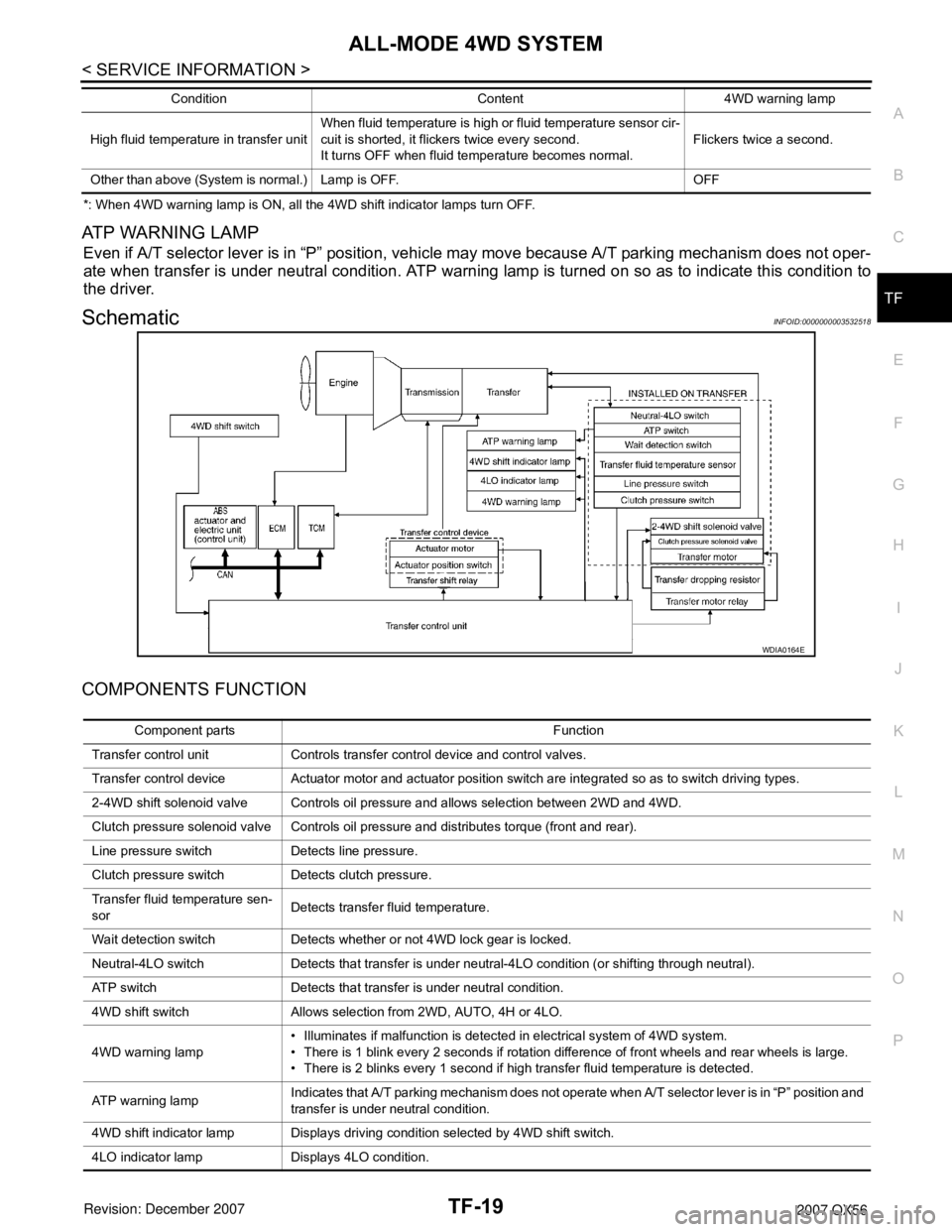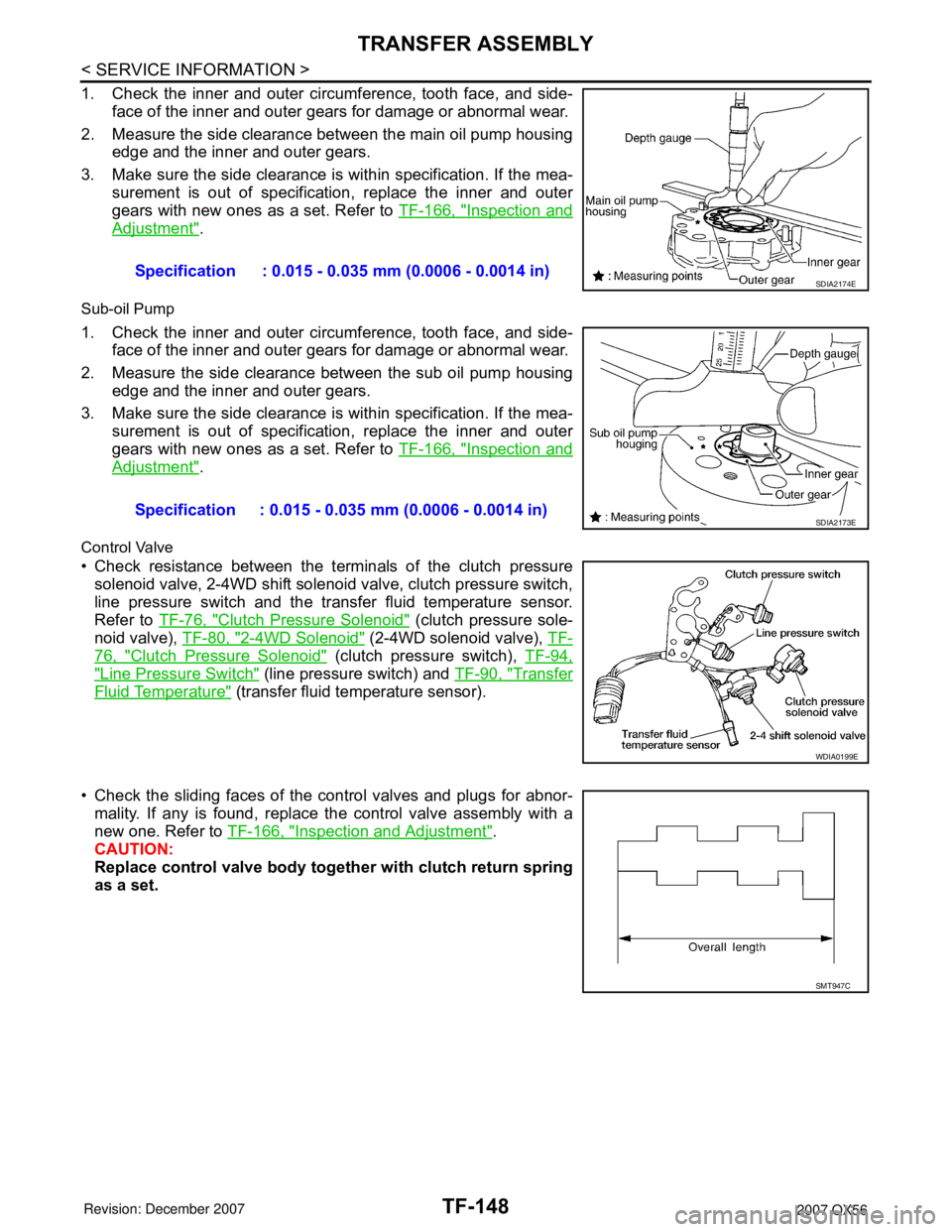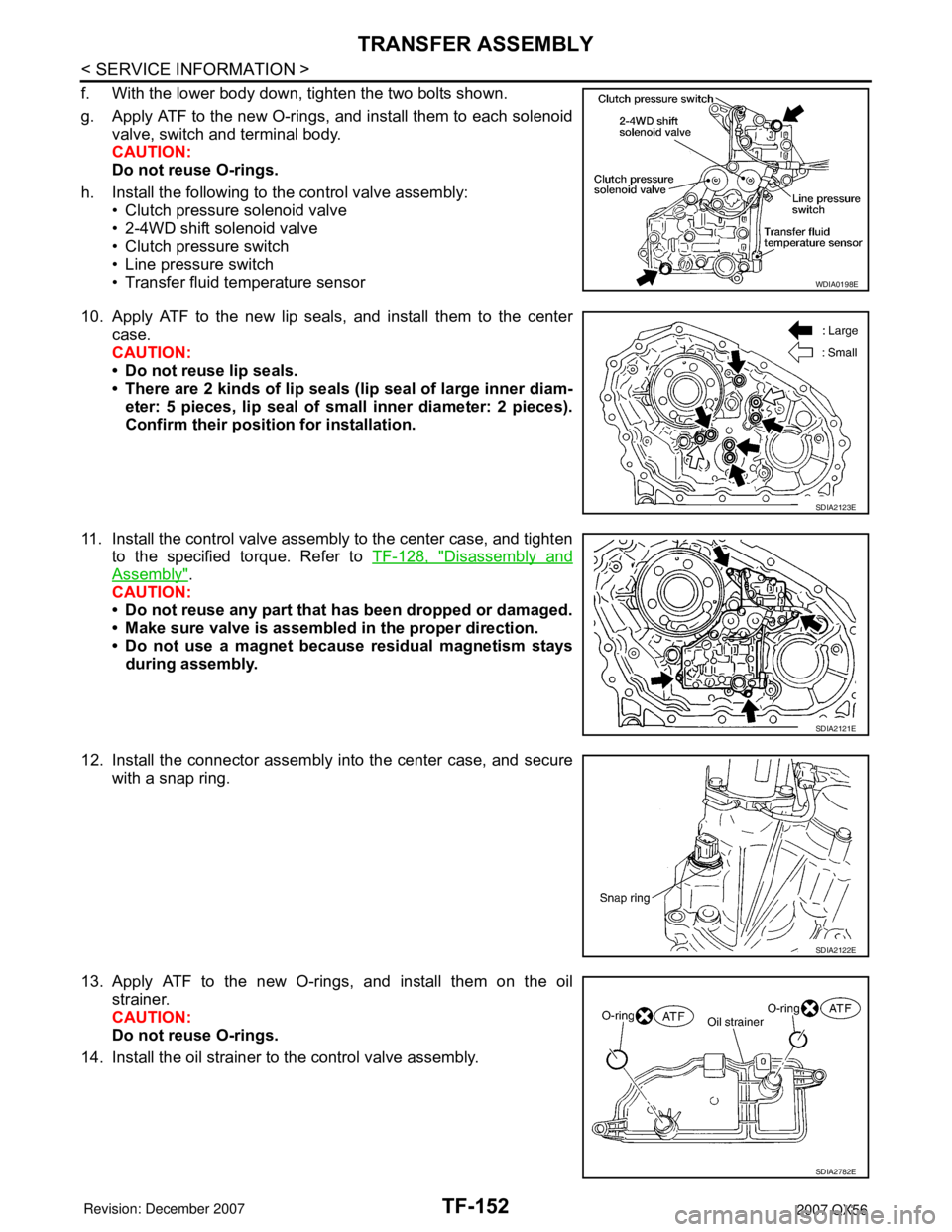2007 INFINITI QX56 oil temperature
[x] Cancel search: oil temperaturePage 2840 of 3061

TF-18
< SERVICE INFORMATION >
ALL-MODE 4WD SYSTEM
LINE PRESSURE SWITCH
• With the transfer system design, control of the oil pressure provides the transmission of drive torque to the
front wheels. The main pressure to control the oil pressure is referred to as the line pressure.
• The line pressure switch determines whether or not adequate line pressure has built up under different oper-
ating conditions.
• The line pressure switch turns ON when line pressure is produced.
• The line pressure switch senses line pressure abnormalities and turns the 4WD warning lamp ON.
CLUTCH PRESSURE SWITCH
• The clutch pressure switch determines whether or not adequate clutch pressure has built up under different
operating conditions.
• The clutch pressure switch turns ON when clutch pressure is produced.
• The clutch pressure switch senses clutch pressure abnormalities and turns the 4WD warning lamp ON.
TRANSFER FLUID TEMPERATURE SENSOR
The transfer temperature sensor detects the transfer fluid temperature and sends a signal to the transfer con-
trol unit.
TRANSFER CONTROL UNIT
• Transfer control unit controls transfer control device by input signals of each sensor and each switch.
• Self-diagnosis can be done.
TRANSFER CONTROL DEVICE
The transfer control device changes the state of transfer assembly between 2WD, AUTO, 4H⇔4LO with the
2WD, AUTO, 4H and 4LO signals of 4WD shift switch.
NOTE:
• To shift between 4H⇔4LO, stop the vehicle, depress the brake pedal and shift the transmission selector to
the "N" position. Depress and turn the 4WD shift switch. The shift switch will not shift to the desired mode if
the transmission is not in "N" or the vehicle is moving. The 4LO indicator lamp will be lit when the 4LO is
engaged.
• Actuator motor and actuator position switch are integrated.
4WD SHIFT SWITCH AND INDICATOR LAMP
4WD Shift Switch
The 4WD shift switch allows selection from 2WD, AUTO, 4H or 4LO.
4WD Shift Indicator Lamp
• Displays driving conditions selected by 4WD shift switch with 2WD, AUTO and 4H indicators while engine is
running. (When 4WD warning lamp is turned on, all 4WD shift indicator lamps are turned off.)
• Turns ON for approximately 1 second when ignition switch is turned ON, for purpose of lamp check.
4LO Indicator Lamp
• Displays 4LO condition while engine is running. 4LO indicator lamp flashes if transfer gear does not shift
completely under 2WD, AUTO, 4H⇔4LO. (When 4WD warning lamp is turned on, 4LO indicator lamp is
turned off.)
• Turns ON for approximately 1 second when ignition switch is turned ON, for purpose of lamp check.
4WD WARNING LAMP
Turns ON or FLASH when there is a malfunction in 4WD system.
Also turns ON when ignition switch is turned ON, for purpose of lamp check. Turns OFF for approximately 1
second after the engine starts if system is normal.
4WD Warning Lamp Indication
Condition Content 4WD warning lamp
During self-diagnosis Indicates the malfunction position by number of flickers. Flickers at malfunction mode.
Lamp check*Checks the lamp by turning ON during engine starting. After
engine starts, it turns OFF if there are no malfunctions.ON
Malfunction in 4WD system*Turns ON to indicate malfunction. When ignition switch is
turned to “OFF” or the malfunction is corrected, it turns OFF.ON
When vehicle is driven with different
diameters of front and rear tiresFlickers once every 2 seconds.
Turns OFF when ignition switch is “OFF”.Flickers once every 2 sec-
onds.
Page 2841 of 3061

ALL-MODE 4WD SYSTEM
TF-19
< SERVICE INFORMATION >
C
E
F
G
H
I
J
K
L
MA
B
TF
N
O
P
*: When 4WD warning lamp is ON, all the 4WD shift indicator lamps turn OFF.
ATP WARNING LAMP
Even if A/T selector lever is in “P” position, vehicle may move because A/T parking mechanism does not oper-
ate when transfer is under neutral condition. ATP warning lamp is turned on so as to indicate this condition to
the driver.
SchematicINFOID:0000000003532518
COMPONENTS FUNCTION
High fluid temperature in transfer unitWhen fluid temperature is high or fluid temperature sensor cir-
cuit is shorted, it flickers twice every second.
It turns OFF when fluid temperature becomes normal.Flickers twice a second.
Other than above (System is normal.) Lamp is OFF. OFFCondition Content 4WD warning lamp
WDIA0164E
Component parts Function
Transfer control unit Controls transfer control device and control valves.
Transfer control device Actuator motor and actuator position switch are integrated so as to switch driving types.
2-4WD shift solenoid valve Controls oil pressure and allows selection between 2WD and 4WD.
Clutch pressure solenoid valve Controls oil pressure and distributes torque (front and rear).
Line pressure switch Detects line pressure.
Clutch pressure switch Detects clutch pressure.
Transfer fluid temperature sen-
sorDetects transfer fluid temperature.
Wait detection switch Detects whether or not 4WD lock gear is locked.
Neutral-4LO switch Detects that transfer is under neutral-4LO condition (or shifting through neutral).
ATP switch Detects that transfer is under neutral condition.
4WD shift switch Allows selection from 2WD, AUTO, 4H or 4LO.
4WD warning lamp• Illuminates if malfunction is detected in electrical system of 4WD system.
• There is 1 blink every 2 seconds if rotation difference of front wheels and rear wheels is large.
• There is 2 blinks every 1 second if high transfer fluid temperature is detected.
AT P w a r n i n g l a m pIndicates that A/T parking mechanism does not operate when A/T selector lever is in “P” position and
transfer is under neutral condition.
4WD shift indicator lamp Displays driving condition selected by 4WD shift switch.
4LO indicator lamp Displays 4LO condition.
Page 2866 of 3061
![INFINITI QX56 2007 Factory Service Manual TF-44
< SERVICE INFORMATION >
TROUBLE DIAGNOSIS
CAUTION:
• If “CAN COMM CIRCUIT [U1000]” is displayed with other DTCs, first perform the trouble diagnosis for CAN communication
line.
• If “V INFINITI QX56 2007 Factory Service Manual TF-44
< SERVICE INFORMATION >
TROUBLE DIAGNOSIS
CAUTION:
• If “CAN COMM CIRCUIT [U1000]” is displayed with other DTCs, first perform the trouble diagnosis for CAN communication
line.
• If “V](/manual-img/42/57029/w960_57029-2865.png)
TF-44
< SERVICE INFORMATION >
TROUBLE DIAGNOSIS
CAUTION:
• If “CAN COMM CIRCUIT [U1000]” is displayed with other DTCs, first perform the trouble diagnosis for CAN communication
line.
• If “VHCL SPEED SEN·AT [P1808]”, “ABS OP SIG [P1830]”, “VDC OP SIG [P1831]” or “TCS OP SIG [P1832]” is displayed, first
perform the trouble diagnosis for ABS system.
• If “VHCL SPEED SEN·AT [P1808]”, is displayed, first perform the trouble diagnosis for A/T system.
NOTE:
• If "SHIFT ACT POSI SW [P1818]" or “SHIFT ACT CIR [P1819]” is displayed, first erase self-diagnostic results. ("SHIFT ACT POSI SW
[P1818]" or “SHIFT ACT CIR [P1819]” may be displayed after installing transfer control unit or transfer assembly.)
• If “CL PRES SW [P1827]” or “LINE PRES SW [P1828]” is displayed only while driving in reverse, check the continuity of “R” position
on A/T PNP switch. When there is nothing wrong with the electrical system, check the hydraulic system.
How to Erase Self-diagnostic Results
1. Perform applicable inspection of malfunctioning item and then repair or replace.
SHIFT ACT CIR
[P1819]• Transfer control device actuator circuit is shorted or open. (Mal-
functions are detected when transfer shift relay circuit is open/
shorted or relay monitor circuit is open/shorted.)
• Malfunction occurs in transfer control device drive circuit.
• Malfunction is detected in transfer shut off relay.TF-72, "Transfer Control Device"
Malfunction is detected in transfer shut off relay.TF-51, "Power Supply Circuit for
Transfer Control Unit"
ENGINE SPEED SIG
[P1820]• Malfunction is detected in engine speed signal that is output from
ECM through CAN communication.
• Improper signal is input while driving.TF-76, "Engine Speed Signal
(ECM)"
DUTY SOLENOID
[P1822]• Proper voltage is not applied to clutch pressure solenoid valve
due to open or short circuit.TF-76, "Clutch Pressure Sole-
noid"
2-4WD SOLENOID
[P1823]• Proper voltage is not applied to 2-4WD solenoid valve due to open
or short circuit.TF-80, "2-4WD Solenoid"
MOTOR RELAY
[P1824]• Motor does not operate properly due to open or short circuit in
transfer motor or motor relay.TF-84, "Transfer Motor"
OIL TEMP SEN
[P1826]• Signal voltage from fluid temperature sensor is abnormally high
(Transfer fluid temperature is abnormally low) while driving.TF-90, "Transfer Fluid Tempera-
ture"
CLUTCH PRES SW
[P1827]• Improper signal from clutch pressure switch is input due to open or
short circuit.
• Malfunction occurs in clutch pressure switch or hydraulic circuit.TF-92, "Clutch Pressure Switch"
LINE PRES SW
[P1828]• Improper signal from line pressure switch is input due to open or
short circuit.
• Malfunction occurs in line pressure switch or hydraulic circuit.TF-94, "Line Pressure Switch"
THROTTLE POSI SEN
[P1829]• Malfunction is detected in accelerator pedal position signal that is
output from ECM through CAN communication.
• Signal voltage from accelerator pedal position sensor is abnormal-
ly high or low.TF-97, "Throttle Position Signal
(ECM)"
ABS OP SIG
[P1830]• Malfunction is detected in ABS operation signal that is output from
ABS actuator and electric unit (control unit) through CAN commu-
nication.TF-97, "ABS Operation Signal
(ABS)"
VDC OP SIG
[P1831]• Malfunction is detected in VDC operation signal that is output from
ABS actuator and electric unit (control unit) through CAN commu-
nication.TF-98, "VDC Operation Signal
(ABS)"
TCS OP SIG
[P1832]• Malfunction is detected in TCS operation signal that is output from
ABS through CAN communication.TF-98, "TCS Operation Signal
(ABS)"
CAN COMM CIRCUIT
[U1000]• Malfunction has been detected from CAN communication line.TF-99, "CAN Communication
Line"
NO DTC IS DETECTED.
FURTHER TESTING MAY
BE REQUIRED.• No NG item has been detected. — Items (CONSULT-II screen
terms)Diagnostic item is detected when... Check item
Page 2970 of 3061

TF-148
< SERVICE INFORMATION >
TRANSFER ASSEMBLY
1. Check the inner and outer circumference, tooth face, and side-
face of the inner and outer gears for damage or abnormal wear.
2. Measure the side clearance between the main oil pump housing
edge and the inner and outer gears.
3. Make sure the side clearance is within specification. If the mea-
surement is out of specification, replace the inner and outer
gears with new ones as a set. Refer to TF-166, "
Inspection and
Adjustment".
Sub-oil Pump
1. Check the inner and outer circumference, tooth face, and side-
face of the inner and outer gears for damage or abnormal wear.
2. Measure the side clearance between the sub oil pump housing
edge and the inner and outer gears.
3. Make sure the side clearance is within specification. If the mea-
surement is out of specification, replace the inner and outer
gears with new ones as a set. Refer to TF-166, "
Inspection and
Adjustment".
Control Valve
• Check resistance between the terminals of the clutch pressure
solenoid valve, 2-4WD shift solenoid valve, clutch pressure switch,
line pressure switch and the transfer fluid temperature sensor.
Refer to TF-76, "
Clutch Pressure Solenoid" (clutch pressure sole-
noid valve), TF-80, "
2-4WD Solenoid" (2-4WD solenoid valve), TF-
76, "Clutch Pressure Solenoid" (clutch pressure switch), TF-94,
"Line Pressure Switch" (line pressure switch) and TF-90, "Transfer
Fluid Temperature" (transfer fluid temperature sensor).
• Check the sliding faces of the control valves and plugs for abnor-
mality. If any is found, replace the control valve assembly with a
new one. Refer to TF-166, "
Inspection and Adjustment".
CAUTION:
Replace control valve body together with clutch return spring
as a set.Specification : 0.015 - 0.035 mm (0.0006 - 0.0014 in)
SDIA2174E
Specification : 0.015 - 0.035 mm (0.0006 - 0.0014 in)SDIA2173E
WDIA0199E
SMT947C
Page 2974 of 3061

TF-152
< SERVICE INFORMATION >
TRANSFER ASSEMBLY
f. With the lower body down, tighten the two bolts shown.
g. Apply ATF to the new O-rings, and install them to each solenoid
valve, switch and terminal body.
CAUTION:
Do not reuse O-rings.
h. Install the following to the control valve assembly:
• Clutch pressure solenoid valve
• 2-4WD shift solenoid valve
• Clutch pressure switch
• Line pressure switch
• Transfer fluid temperature sensor
10. Apply ATF to the new lip seals, and install them to the center
case.
CAUTION:
• Do not reuse lip seals.
• There are 2 kinds of lip seals (lip seal of large inner diam-
eter: 5 pieces, lip seal of small inner diameter: 2 pieces).
Confirm their position for installation.
11. Install the control valve assembly to the center case, and tighten
to the specified torque. Refer to TF-128, "
Disassembly and
Assembly".
CAUTION:
• Do not reuse any part that has been dropped or damaged.
• Make sure valve is assembled in the proper direction.
• Do not use a magnet because residual magnetism stays
during assembly.
12. Install the connector assembly into the center case, and secure
with a snap ring.
13. Apply ATF to the new O-rings, and install them on the oil
strainer.
CAUTION:
Do not reuse O-rings.
14. Install the oil strainer to the control valve assembly.
WDIA0198E
SDIA2123E
SDIA2121E
SDIA2122E
SDIA2782E